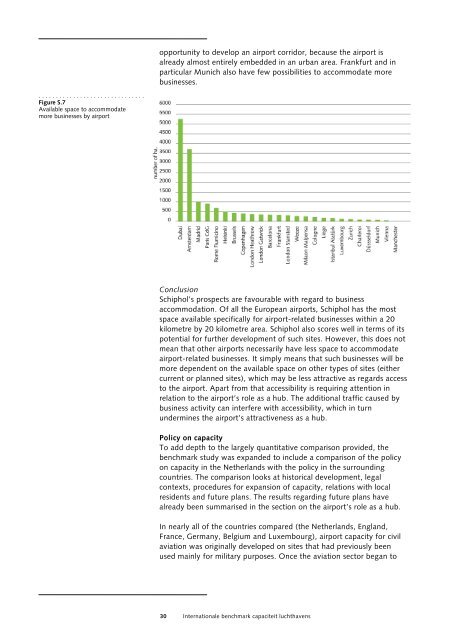Internationale benchmark capaciteit luchthavens - Kennisinstituut ...
Internationale benchmark capaciteit luchthavens - Kennisinstituut ...
Internationale benchmark capaciteit luchthavens - Kennisinstituut ...
You also want an ePaper? Increase the reach of your titles
YUMPU automatically turns print PDFs into web optimized ePapers that Google loves.
. . . . . . . . . . . . . . . . . . . . . . . . . . . . . . .<br />
Figure S.7<br />
Available space to accommodate<br />
more businesses by airport<br />
opportunity to develop an airport corridor, because the airport is<br />
already almost entirely embedded in an urban area. Frankfurt and in<br />
particular Munich also have few possibilities to accommodate more<br />
businesses.<br />
Conclusion<br />
Schiphol’s prospects are favourable with regard to business<br />
accommodation. Of all the European airports, Schiphol has the most<br />
space available specifically for airport-related businesses within a 20<br />
kilometre by 20 kilometre area. Schiphol also scores well in terms of its<br />
potential for further development of such sites. However, this does not<br />
mean that other airports necessarily have less space to accommodate<br />
airport-related businesses. It simply means that such businesses will be<br />
more dependent on the available space on other types of sites (either<br />
current or planned sites), which may be less attractive as regards access<br />
to the airport. Apart from that accessibility is requiring attention in<br />
relation to the airport’s role as a hub. The additional traffic caused by<br />
business activity can interfere with accessibility, which in turn<br />
undermines the airport’s attractiveness as a hub.<br />
Policy on capacity<br />
To add depth to the largely quantitative comparison provided, the<br />
<strong>benchmark</strong> study was expanded to include a comparison of the policy<br />
on capacity in the Netherlands with the policy in the surrounding<br />
countries. The comparison looks at historical development, legal<br />
contexts, procedures for expansion of capacity, relations with local<br />
residents and future plans. The results regarding future plans have<br />
already been summarised in the section on the airport’s role as a hub.<br />
In nearly all of the countries compared (the Netherlands, England,<br />
France, Germany, Belgium and Luxembourg), airport capacity for civil<br />
aviation was originally developed on sites that had previously been<br />
used mainly for military purposes. Once the aviation sector began to<br />
30 <strong>Internationale</strong> <strong>benchmark</strong> <strong>capaciteit</strong> <strong>luchthavens</strong>




